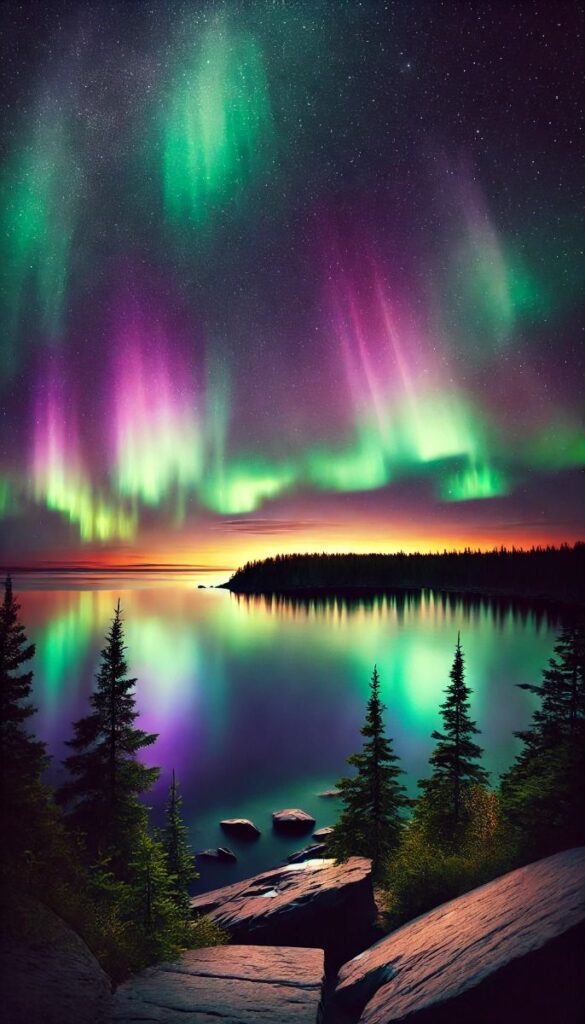After the Perseid meteor shower peak on August 11, a celestial treat of the Northern Lights, often known as Aurora Borealis, was served by the geomagnetic storm across the Midwest and Northern U.S. on the following night (August 12).

What is the Aurora Borealis?
Aurora Borealis is a Latin phrase which means: Aurora — the light and Borealis–Northern; so they are the natural ‘Northern Lights’, predominantly seen in high-latitude regions of the Northern Hemisphere.

Why are Aurora lights so colorful?
When the charged particles from Sun, mainly electrons and protons, collide with gases (oxygen and nitrogen)in Earth’s atmosphere, the gases emit beautiful, colorful lights in the sky.
The different colors of the Aurora are due to the interaction with oxygen at lower altitudes. Green is the most common color. Red, blue, and purple hues can also appear, depending on the type of gas involved and the altitude of the collisions.
The best places to watch the Northern Lights:
The phenomenon is best viewed in locations within the Northern Polar Regions, such as northern Norway, Sweden, Finland, Canada, and Alaska, during the winter months when the nights are longest and the skies are darkest.
Aurora of the South

The Southern Hemisphere has its version of the Northern Lights called the Aurora Australis; here, Australis means the South. Just like the Northern Lights, the Southern Lights are caused by the interaction between charged particles from the sun and gases in Earth’s atmosphere. The Southern Aurora has the same vibrant colors and dancing patterns.
The best places to view the Aurora Australis
It can be seen in high-latitude regions near the South Pole, such as southern New Zealand, Tasmania (Australia), Antarctica, and sometimes in southern parts of Argentina and Chile.
Does the Northern Hemisphere receive more Aurora than the southern hemisphere?

Both poles experience the same phenomena, but the Southern Lights are less commonly observed than the Northern Lights, mainly because fewer people live in or visit the remote southern regions where they occur.
How to see the Auroras Borealis?
Seeing Aurora Borealis is a magical experience, but it requires some planning and a bit of luck. Let’s explore the ways to maximize the chances of witnessing this natural phenomenon:
Choose the right location:

High-latitude regions are the best places to see the Northern Lights because they are near the Arctic Circle (Aurora Zone), such as Norway, Sweden, Finland, Canada, and Alaska. The further north, offers better chances.
Winter Months:
The best time to see the Northern Lights is during the winter, typically from late September to early April when nights are the longest and darkest.
The Northern Lights are more active during periods of high ‘Solar Activity’, which follow an 11-year solar cycle.
Clear Skies:
To see the Auroras, choose a location with a clear sky, as a cloudy sky can obstruct the view. Cold, crisp nights often coincide with clear skies, making them ideal for Aurora watching.
Monitor Aurora Forecasts:

Follow the real-time Aurora Alerts provided by websites such as the NOAA (Space Weather Prediction Center) or AuroraWatch UK. These resources will tell you the Kp index (min 0 to max 9), which indicates the strength of the aurora. A Kp index of 5 or higher increases your chances of seeing the lights.
Find a Dark, Open Space:
Head to a location far from city lights and pollution where the sky is darkest. Wide open spaces with an unobstructed view of the northern horizon, such as open fields, lakes, or hilltops are the best.
Stay patient and dress warmly:

The Northern Lights are unpredictable. You may need to wait for several hours or even multiple nights to catch a glimpse. Dress in layers, as it can get very cold, especially when you’re standing outside for extended periods.
Bring the right equipment:
If you want to photograph the Northern Lights, bring a camera with manual settings, a tripod, and a wide-angle lens. Set a long exposure time (5–30 seconds) to capture the lights. To preserve night vision, a headlamp or flashlight with a red filter can be helpful.
Local Expertise:
Guided tours are available in popular aurora viewing regions. These guides know the best spots and can increase your chances of seeing the lights.
Aurora Lights are one of nature’s most breath-taking spectacles and one must experience the beauty of these awe-inspiring Northern Lights at least ones in his lifetime.
To read about Meteor Shower click the link
Images Sources: Pinterest.com
swpcnoaa.gov
video credits: youtube.com

